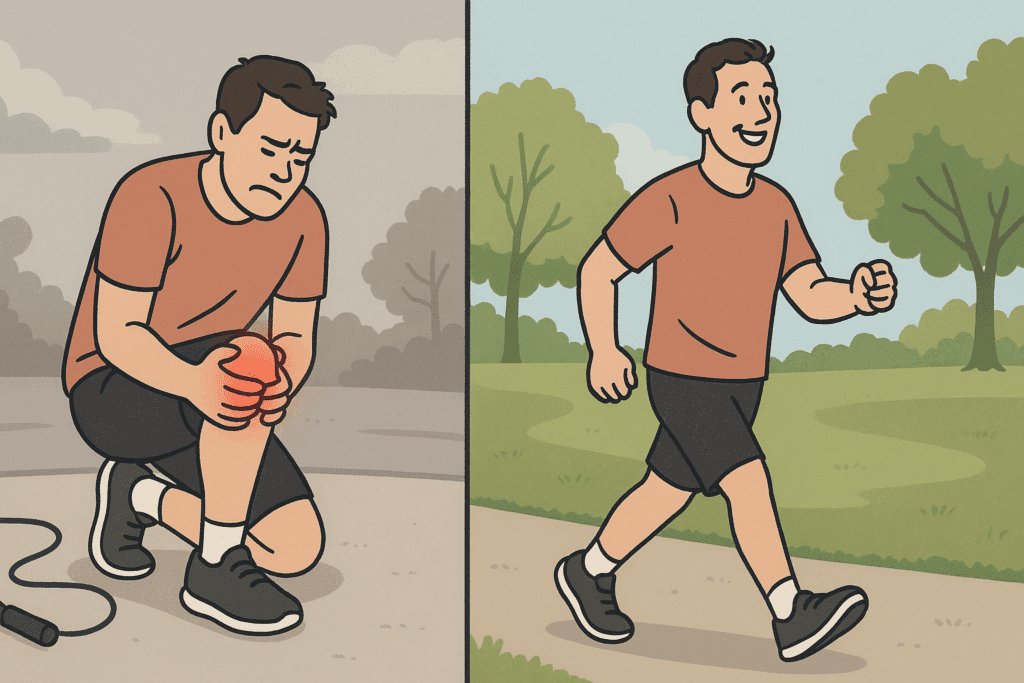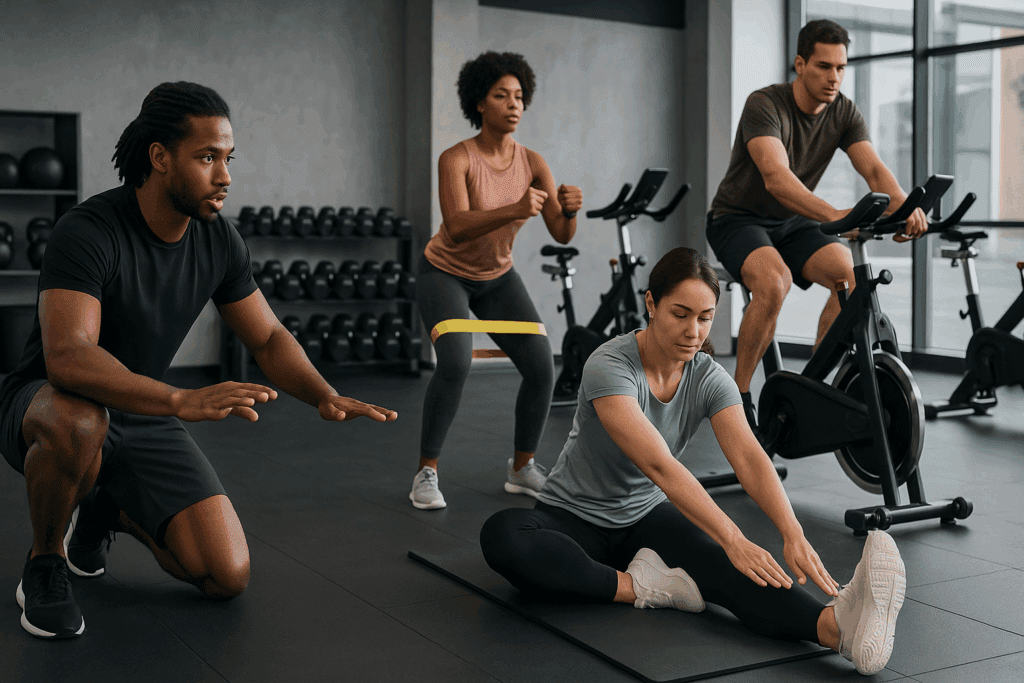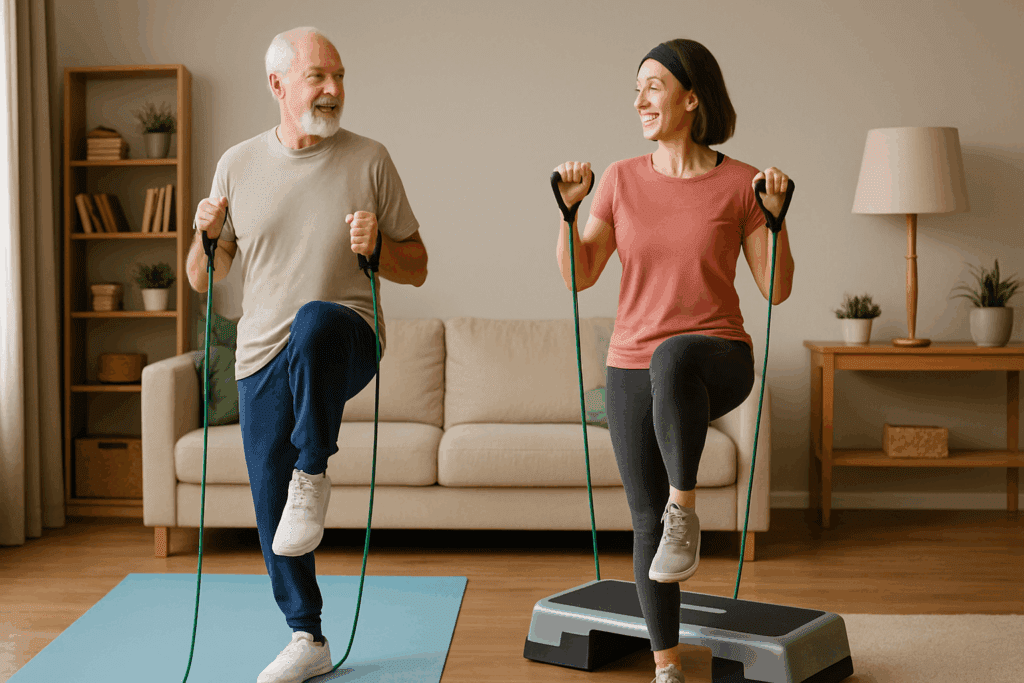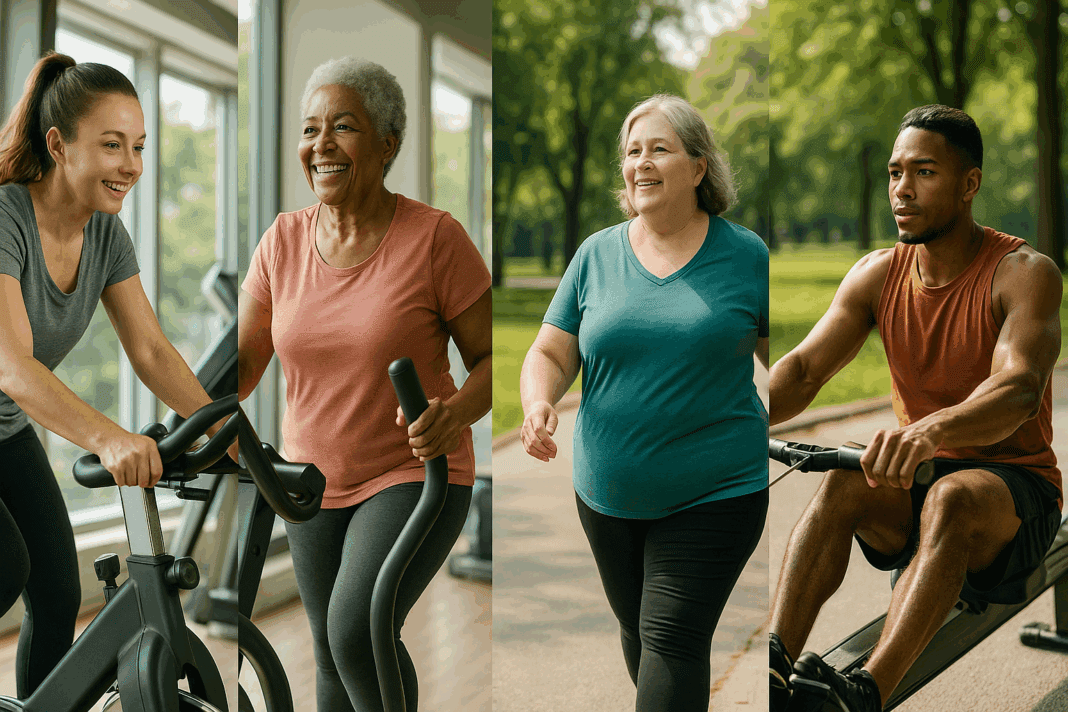Cardiovascular training is a cornerstone of physical health, endurance, and athletic performance. For many, however, the traditional image of cardio evokes high-impact movements like jumping jacks, burpees, or sprint intervals. While these exercises are effective, they are not universally suitable. People recovering from injuries, individuals with joint issues, those who are overweight, or anyone simply seeking a gentler form of exercise can all benefit from low-impact alternatives. Fortunately, cardio without jumping is not only possible—it can be highly effective. In fact, a well-structured cardio workout without jumping can build endurance, improve heart health, and support long-term performance gains naturally and sustainably.
You may also like: How to Increase Stamina and Endurance Naturally: Smart Training Tips and Nutrition Habits That Support Cardiovascular Fitness

Why Choose Low-Impact Cardio?
The growing popularity of low-impact fitness regimens is not merely a trend—it reflects a broader shift toward inclusivity and sustainability in health practices. For many, the stress that jumping movements place on the knees, ankles, and lower back can lead to discomfort or even chronic pain. Others might be dealing with pre-existing medical conditions that preclude them from engaging in high-impact exercises. Low-impact cardio workouts without jumping provide a meaningful alternative that supports cardiovascular health without exacerbating joint stress.
Moreover, these exercises promote consistency. The sustainability of a fitness program often determines its effectiveness, and individuals are more likely to stick with a routine that doesn’t cause pain or feel intimidating. Non jumping cardio routines are accessible to people of all ages and fitness levels, from beginners to seasoned athletes who need a recovery-day option. They also align with principles of longevity-focused training, emphasizing injury prevention and balanced progress.
The Science Behind Endurance Building Without Impact
To understand how cardio exercises without jumping build endurance, it’s important to consider the physiology of cardiovascular adaptation. Cardio workouts aim to elevate heart rate, improve oxygen consumption (VO2 max), and enhance the efficiency of the heart and lungs. Low-impact movements can still stimulate these responses if performed with adequate intensity, duration, and frequency.
Research in exercise science demonstrates that activities such as brisk walking, cycling, swimming, rowing, and elliptical training can significantly improve aerobic capacity. These exercises rely on continuous, rhythmic movements that engage large muscle groups, leading to cardiovascular adaptations over time. Importantly, they avoid the abrupt, high-force landings associated with jumping. In other words, it’s not the impact that makes cardio effective—it’s the sustained movement and elevated heart rate.
This distinction is critical for individuals designing a workout routine that supports both performance enhancement and joint preservation. Cardio without jumping can be just as metabolically demanding as its high-impact counterparts, especially when coupled with resistance elements, interval training, or longer durations. The body responds to consistent demand by becoming more efficient, thereby improving stamina and endurance.

Top Low-Impact Cardio Options That Skip the Jumping
For those seeking workouts without jumping, the options are both diverse and adaptable. One of the most popular choices is brisk walking, especially when done at an incline or in intervals. Incline walking engages the posterior chain and increases heart rate without stressing the joints. Walking may seem simplistic, but its benefits are profound when practiced regularly and with purpose.
Another excellent low-impact option is cycling. Whether on a stationary bike or outdoors, cycling offers a joint-friendly way to engage in steady-state or interval cardio. It’s especially effective for strengthening the quadriceps, glutes, and calves while also enhancing cardiovascular endurance. For those who prefer indoor workouts, the elliptical machine simulates running without the jarring impact, making it a favorite among rehabilitation professionals and endurance athletes alike.
Rowing is another underappreciated yet powerful form of non jumping cardio. It’s a full-body exercise that recruits the legs, core, back, and arms in a coordinated effort, offering both strength and endurance benefits. Swimming also stands out as a virtually zero-impact cardio exercise, ideal for those with joint pain or mobility issues. The buoyancy of water supports the body, allowing for vigorous activity with minimal strain.
How to Structure a Cardio Workout Without Jumping
Creating an effective cardio workout without jumping involves more than choosing the right exercises—it requires strategic planning. A well-rounded session should include a warm-up, a main workout phase, and a cool-down. The warm-up prepares the muscles and cardiovascular system, gradually increasing heart rate and reducing injury risk. This might involve dynamic stretches, gentle marching in place, or low-resistance cycling.
The main workout phase can be tailored to the individual’s goals. For endurance training, longer sessions of steady-state cardio are ideal. This could mean 30–60 minutes of brisk walking, cycling, or swimming at a moderate intensity. For those aiming to improve both stamina and metabolic health, interval training offers a more time-efficient option. For example, alternating between one minute of fast-paced elliptical work and two minutes of moderate effort creates a challenging yet joint-friendly interval structure.
Resistance elements can also be woven into a cardio session to enhance muscular endurance. Exercises like step-ups, chair squats, and resistance band pulls can be performed in a circuit-style format with minimal rest to maintain an elevated heart rate. These movements are not only accessible but scalable, making them suitable for all fitness levels.

Addressing Misconceptions About Low-Impact Training
A common misconception is that cardio exercises without jumping are inherently less effective or insufficient for athletic development. This belief often stems from the visual intensity associated with high-impact training. However, intensity does not always equate to effectiveness. In fact, low-impact cardio can foster greater consistency, reduce recovery time, and support sustainable long-term progress.
Another myth is that non jumping cardio cannot help with weight loss. In reality, any exercise that elevates the heart rate and is performed consistently can support fat metabolism and caloric expenditure. What’s more, low-impact workouts reduce the likelihood of injury, which can derail weight loss efforts by disrupting training schedules. A strong cardiovascular system also supports hormonal regulation, mental clarity, and sleep—all factors that influence body composition.
It is also worth noting that low-impact training can be progressive. As endurance improves, individuals can increase the duration, resistance, or intensity of their chosen activities. Using a heart rate monitor or tracking perceived exertion can help ensure that workouts remain challenging and effective. Progression does not require impact—it requires intention and consistency.
Incorporating Low-Impact Cardio into a Performance Enhancement Plan
Athletes and high-performing individuals often look to maximize gains with minimal setbacks. Integrating cardio without jumping into a performance enhancement regimen can provide critical benefits. For example, low-impact workouts are ideal for active recovery days. They keep blood flowing to the muscles, aid in the removal of metabolic waste, and reduce soreness—all while preserving energy for high-intensity training sessions.
Endurance sports, in particular, benefit from the inclusion of non jumping cardio sessions. Cyclists, swimmers, and runners often use cross-training methods to reduce the repetitive strain of their primary sport. A cyclist might swim to maintain aerobic conditioning while giving their hips and knees a break. A runner recovering from shin splints might use the elliptical or rowing machine to preserve cardiovascular gains without aggravating their injury.
Furthermore, low-impact cardio is invaluable during off-season training or rehabilitation. It offers a means of maintaining base fitness when high-impact work is not advisable. From a psychological perspective, the reduced risk of injury and lower perceived exertion can enhance enjoyment and reduce burnout, making it easier to stick to a consistent training plan over time.

Practical Tips for Maximizing Results with Non Jumping Cardio
To get the most out of cardio workouts without jumping, consider several evidence-based strategies. First, consistency is crucial. Endurance builds over time, and regular sessions—ideally three to five times per week—are necessary to elicit physiological adaptations. Even low-intensity workouts add up when practiced regularly.
Second, variation can keep routines engaging and effective. Mixing different forms of non jumping cardio—such as alternating between rowing and cycling throughout the week—targets different muscle groups and prevents overuse injuries. It also maintains mental stimulation, which is vital for long-term adherence.
Third, monitor your intensity. Using a rate of perceived exertion (RPE) scale or a heart rate monitor can ensure that your workouts are sufficiently challenging. Aim for a mix of moderate-intensity sessions, where breathing becomes deeper but conversation is still possible, and higher-intensity intervals where effort is noticeably harder.
Nutrition, hydration, and sleep also play an essential role in maximizing the benefits of any exercise program. Ensure that your body is fueled and rested to recover from and adapt to workouts. Low-impact doesn’t mean low-requirement—your body still needs support to perform and recover.

Frequently Asked Questions: Low-Impact Cardio for Endurance and Performance
Can non jumping cardio routines help improve athletic performance in competitive sports?
Absolutely. While explosive movements are often highlighted in athletic training, non jumping cardio has a unique role in refining an athlete’s endurance base and preserving joint health during peak training cycles. Sports that demand sustained cardiovascular output, such as soccer, tennis, or long-distance cycling, benefit from low-impact activities that maintain aerobic conditioning without overstressing muscles and ligaments. Using cardio without jumping, athletes can continue to enhance their VO2 max and cardiovascular efficiency on recovery days. This balance not only extends athletic careers but also reduces injury downtime, keeping performance levels consistently high.
What is the role of posture and form in a cardio workout without jumping?
Proper posture and biomechanics are essential for optimizing the effectiveness of any cardio workout without jumping. Unlike high-impact exercises, which often emphasize rapid motion, low-impact routines demand sustained form to ensure steady muscle activation and joint protection. Maintaining an upright spine, relaxed shoulders, and engaged core enhances the efficiency of movement and ensures better oxygen delivery throughout the workout. In cycling or elliptical training, for instance, small adjustments in posture can significantly improve comfort and power output. Over time, attention to form in cardio exercises without jumping can also enhance posture in daily life, reducing back pain and improving mobility.
Are there psychological benefits to doing cardio exercises without jumping?
Yes, the mental health advantages of low-impact cardio are significant and sometimes even more accessible than those of high-intensity modalities. Cardio exercises without jumping tend to promote a meditative rhythm, which is especially beneficial for individuals with anxiety or burnout. The repetitive nature of these exercises, such as rowing or swimming, encourages a state of flow—an immersive mental focus that fosters relaxation and emotional regulation. Additionally, because workouts without jumping are often less intimidating, they create a more inclusive space for beginners or those returning to fitness, supporting confidence and consistency. This emotional comfort can improve adherence, which is critical for achieving long-term mental and physical wellness goals.
How can I increase the intensity of cardio without jumping while staying low-impact?
Progression in non jumping cardio can be achieved through strategic manipulation of variables like resistance, speed, incline, and duration. For example, increasing the incline on a treadmill during walking sessions or adjusting resistance levels on a stationary bike can elevate heart rate without incorporating any impact-based movements. Circuit training formats—alternating between low-impact exercises such as step-ups, battle ropes, or shadow boxing—also offer dynamic, high-intensity options that never leave the ground. Another strategy involves using tempo variations: slowing down certain movements to build strength and control, then speeding up to enhance cardiovascular effort. These methods create an effective cardio workout without jumping while keeping joints protected and intensity high.
Can seniors or those with arthritis benefit from low-impact, non jumping cardio routines?
Definitely. Seniors and individuals with arthritis often face physical limitations that make high-impact workouts uncomfortable or even dangerous. Non jumping cardio offers a safe yet effective pathway to improve heart health, maintain mobility, and manage weight. Exercises like aquatic aerobics, recumbent biking, and walking with poles are excellent for reducing load on the joints while maintaining an active lifestyle. Additionally, regular low-impact cardio can help reduce systemic inflammation, a key contributor to arthritic symptoms, and improve balance and coordination, decreasing fall risk. With tailored guidance, seniors can use cardio exercises without jumping to maintain independence and quality of life.
Are there equipment-free options for effective workouts without jumping?
Yes, you can design highly effective cardio workouts without jumping that require no equipment at all. Marching in place, standing knee lifts, low-impact burpees (excluding the jump), and controlled lateral steps are just a few examples of equipment-free, joint-friendly movements that still elevate the heart rate. The key is to focus on movement continuity and minimal rest to maintain cardiovascular demand. Additionally, stair climbing or using household furniture for step-ups can add functional resistance without the need for gym gear. For those training at home or with limited resources, non jumping cardio provides both convenience and efficacy without compromise.
How does low-impact cardio support long-term weight management?
Sustained, moderate-intensity cardio without jumping plays a vital role in long-term weight regulation by improving metabolic flexibility and supporting hormonal balance. Because low-impact routines can be performed frequently with minimal recovery time, they allow for consistent energy expenditure over time. This cumulative caloric burn, combined with reduced injury risk, makes non jumping cardio ideal for those focusing on body composition goals. Furthermore, such workouts help regulate cortisol levels—important for reducing belly fat and stress-related weight gain. Incorporating cardio exercises without jumping into a comprehensive wellness routine can thus serve as a long-term, maintainable approach to healthy weight control.
What are the emerging trends in low-impact cardio training?
In recent years, innovations in non jumping cardio have expanded beyond traditional methods. Virtual reality cycling and rowing systems are gaining popularity, providing immersive experiences that enhance engagement and motivation. Wearable fitness tech now allows users to fine-tune their cardio workouts without jumping by providing real-time heart rate zones and recovery metrics. Additionally, hybrid programs that combine low-impact cardio with mindfulness practices like breath training or guided movement are on the rise, particularly among those seeking holistic wellness. These developments demonstrate that cardio without jumping continues to evolve in response to demand for accessible, tech-integrated, and mind-body-focused fitness solutions.
Can non jumping cardio still help improve VO2 max and aerobic capacity?
Absolutely. VO2 max—the maximum amount of oxygen the body can use during intense exercise—can be improved through consistent, progressively challenging low-impact workouts. Activities like incline walking, rowing, and resistance cycling place sufficient demand on the cardiovascular system to elicit measurable adaptations over time. By training within target heart rate zones, individuals can track aerobic progress without ever needing to perform high-impact exercises. Importantly, the sustained nature of most cardio exercises without jumping supports longer session durations, which are highly effective for building endurance. Thus, when properly structured, non jumping cardio can be a cornerstone of advanced aerobic development.
How can individuals recovering from injury transition back into cardio safely using low-impact options?
Transitioning back into cardio after an injury requires a cautious, structured approach—and non jumping cardio is ideal for this phase. Rehabilitation protocols often recommend aquatic therapy, recumbent biking, or elliptical training as early-stage reconditioning tools. These exercises maintain cardiovascular engagement without placing stress on healing tissues. As the body adapts, progression can include bodyweight movements like wall squats or standing marches, which further build functional strength and endurance. Working with a physical therapist or certified trainer to integrate a personalized cardio workout without jumping ensures that recovery remains safe, gradual, and aligned with long-term mobility goals.
Conclusion: Building Lasting Stamina with Joint-Friendly Cardio
Choosing cardio without jumping is not a compromise—it’s a strategic, sustainable decision for many individuals looking to boost endurance and enhance performance naturally. Whether you’re recovering from an injury, managing chronic joint discomfort, or simply seeking a low-impact alternative, cardio workouts without jumping can deliver meaningful results. From cycling and swimming to elliptical training and rowing, there are numerous effective cardio exercises without jumping that elevate the heart rate, build stamina, and support overall fitness goals.
Workouts without jumping align with modern fitness philosophies that emphasize longevity, inclusivity, and adaptability. They provide a foundation for consistent training and reduce the risk of setbacks due to overuse or impact-related injuries. Incorporating non jumping cardio into your fitness plan supports not only physical performance but also mental resilience and emotional well-being.
Ultimately, endurance is not just about how far or fast you can go—it’s about how well you can sustain your effort over time. With thoughtfully designed low-impact cardio routines, you can build that endurance without ever leaving the ground. Embrace the power of movement that’s both effective and gentle, and experience how small steps—taken consistently—can lead to lasting gains in stamina, strength, and health.
Was this article helpful? Don’t let it stop with you. Share it right now with someone who needs to see it—whether it’s a friend, a colleague, or your whole network. And if staying ahead on this topic matters to you, subscribe to this publication for the most up-to-date information. You’ll get the latest insights delivered straight to you—no searching, no missing out.
Further Reading:
3 Kinds of Exercise That Boost Heart Health
Try This: 6 Low-Impact Cardio Exercises in 20 Minutes or Less
20 cardio exercises to do at home with minimal equipment, from beginner to advanced

